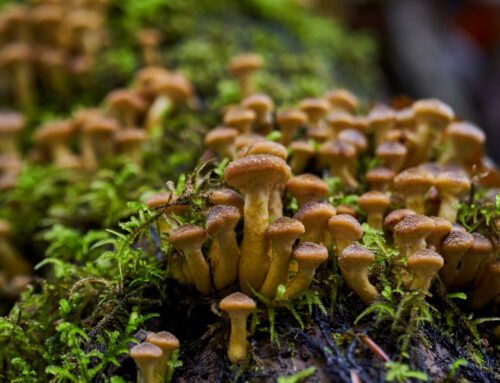It´s late springtime here in the northern hemisphere. Time of flowers and fruits.
Right time to talk about fragrances and tastes.
Have you ever wondered, why exactly the same parfum doesn´t smell same on a different person?
Answer to this, at least partially, comes from our skin microbiomes.
There are two main kinds of sweat glands on human skin. One, more numerous, called eccrine are almost everywhere and are responsible for cooling our body. Other, less numerous, are called apocrine and are located in our armpits, around nipples and genitals. Apocrine glands produce pheromones – chemicals which we (as many other animals) need to attract (or repel) others. So-called “emotional sweating” occurs when we are stressed or excited and it also comes from apocrine glands 1,2.
Sweat produced by both types of glands is colorless and odorless. However, sweat from apocrine glands is oily and contains chemicals such as steroids and various fats. Some of the microbes on our skin degrade these chemicals to smelly products 1,3. Besides individual genetic, metabolic or hormonal differences, answering the question which-kind-of-chemical-can-be-converted-by-which-type-of-skin-microbes-to-which-kind-of smell can be a potential game-changer for various industries: from personal care to cosmetics or fragrance producers.
Antimicrobial substances are typically present in most commonly used deodorants and antiperspirants. When applied on skin, they quickly reduce number of microbes. Problem is, however, that exactly microbes responsible for bad smell are those most likely to survive. Another problem is that substances (such as aluminum salts) used in many antiperspirants reduce sweat production by blocking only secretion from eccrine, but not apocrine glands which, as previously mentioned, are those responsible for creating body odors 2,4. Therefore, new strategies to fight body malodor are urgently needed.
One microbiome-based approach is so-called “microbial transplantation”- basically a transfer of skin microbes from a donor-person (possibly a good smelling one 😊 ) to an acceptor. This can be done directly by taking a swab from a donor and transferring it to a sterilized skin portion of the acceptor, or by growing selected microbes from a donor in the laboratory and then apply them. The latter is safer, because it minimizes possibility of contamination with unwanted microbes. A third possibility is to use only selected live microbial strains (also known as probiotics) in form of skin creams, lotions, oils etc. All of the above-mentioned approaches are currently being experimentally tested and skin products containing probiotics are available from several companies.
Do microbiomes actually influence our sense of smell or taste?
In short, YES, they do.
Researchers have recently shown connections between the diversity of bacteria in nasal cavities and the sense of smell. Namely, people with reduced sense of smell (hyposmia) seem to have higher diversity of nasal bacteria, especially those species able of producing chemicals with strong smell sensations 5. Similarly, specific types of bacteria have been found in higher presence in oral microbiomes (those lining the tongue) of so called “super-tasters” – people with enhanced sensation of taste 6.
The story between microbiomes, smells and tastes doesn´t end in the nose or in the mouth. Nowadays we know that metabolites produced by gut microbes influence our body through the immune, endocrine and nervous system, influencing our appetite and our sensing of nutrients, therefore affecting our eating behavior. Learning more about these mechanisms is a promising option for treatment of health disorders such as obesity, diabetes and others 7,8.
Follow us next week for Part 2: we will continue this story by looking at how microbes can help us with production of parfums, tastes, aromas and fragrances – from natural sources and in the biotech-industry.
Further readings*:
- Barzantny, H., Brune, I. & Tauch, A. Molecular basis of human body odour formation: insights deduced from corynebacterial genome sequences: Molecular basis of human body odour formation. International Journal of Cosmetic Science 34, 2–11 (2012).
- Callewaert, C., Lambert, J. & Van de Wiele, T. Towards a bacterial treatment for armpit malodour. Exp Dermatol 26, 388–391 (2017).
- Mogilnicka, I., Bogucki, P. & Ufnal, M. Microbiota and Malodor—Etiology and Management. IJMS 21, 2886 (2020).
- Callewaert, C., Hutapea, P., Van de Wiele, T. & Boon, N. Deodorants and antiperspirants affect the axillary bacterial community. Arch Dermatol Res 306, 701–710 (2014).
- Koskinen, K. et al. The nasal microbiome mirrors and potentially shapes olfactory function. Sci Rep 8, 1296 (2018).
- Cattaneo, C. et al. New insights into the relationship between taste perception and oral microbiota composition. Sci Rep 9, 3549 (2019).
- Leung, R. & Covasa, M. Do Gut Microbes Taste? Nutrients 13, 2581 (2021).
- Bienenstock, J., Kunze, W. A. & Forsythe, P. Disruptive physiology: olfaction and the microbiome-gut-brain axis: Olfaction and gut-brain axis. Biol Rev 93, 390–403 (2018)
* – we thank Dr. Kristin Neumann from MyMicrobiome AG for providing valuable inputs and references for this blog.





